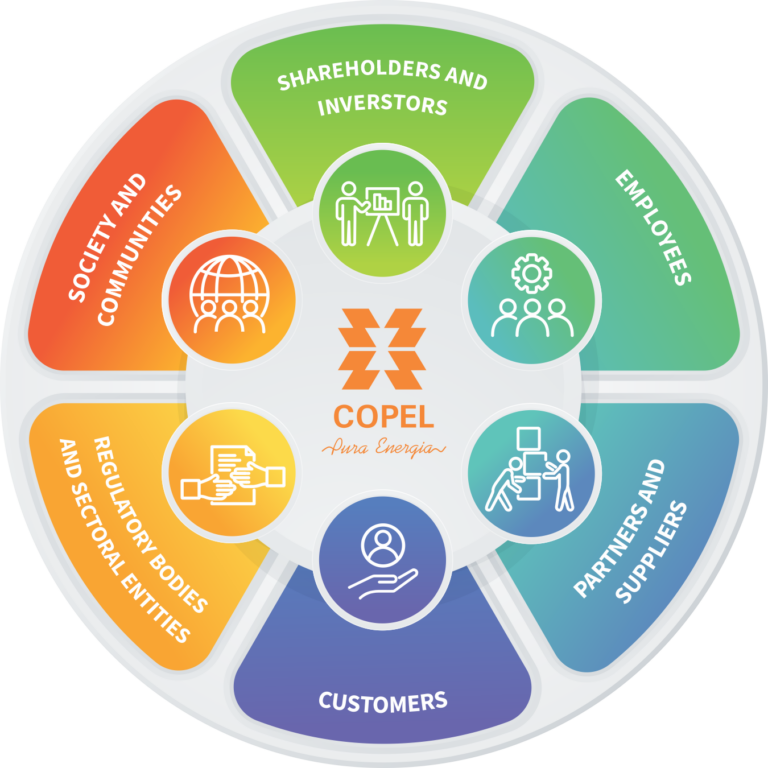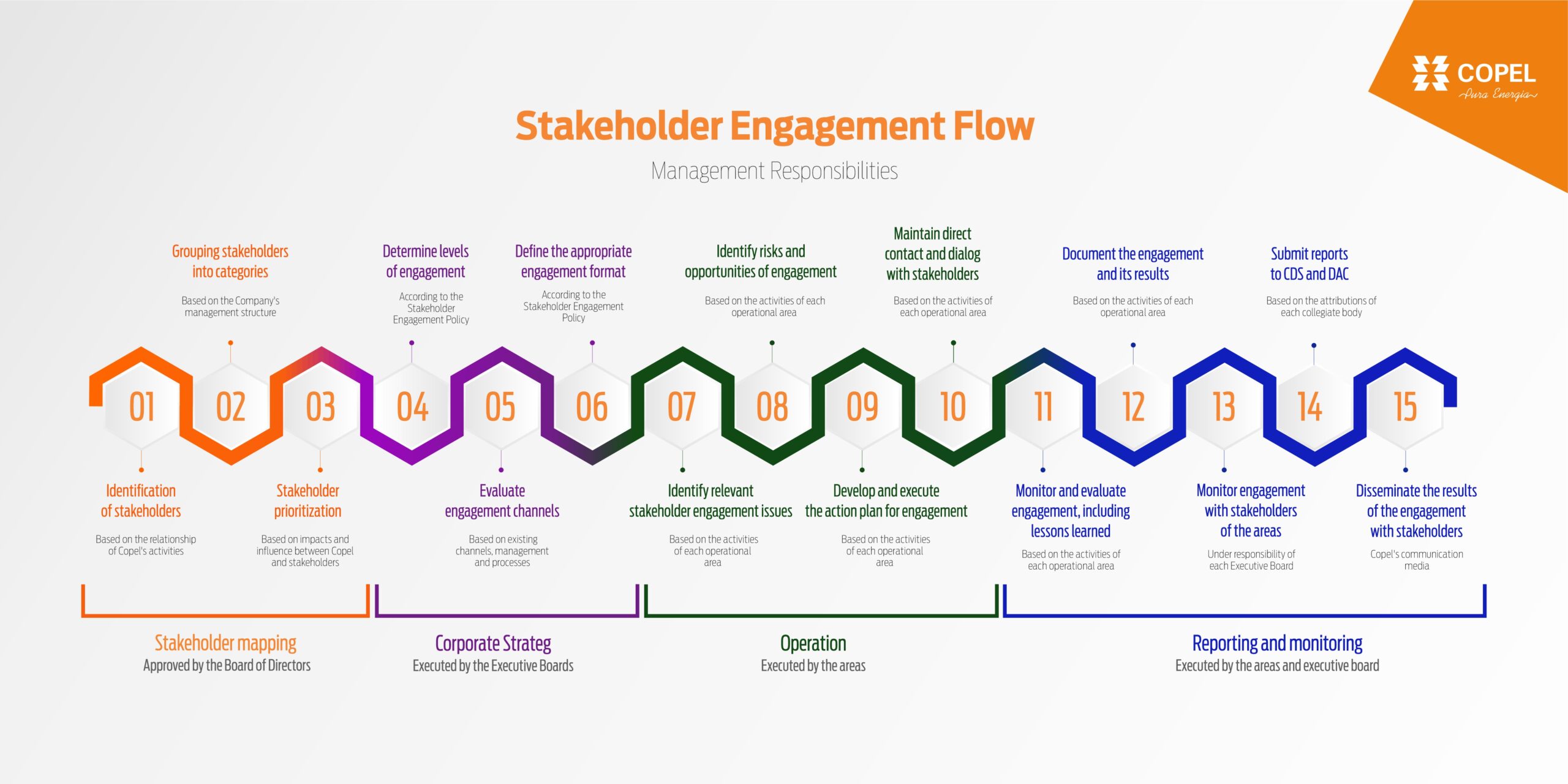Stakeholders
Stakeholders are entities (people, organizations or associations) that can affect or be affected or perceive themselves to be affected by a decision or activity of the organization.
An organization’s stakeholders include shareholders and investors, administrators, employees, customers, suppliers and all those who have any relationship with the organization, affect or are affected by its activities and decisions.
Mapping these interested parties is essential to identify an organization’s material themes, that is, those that represent the most significant impacts in the environmental, social and economic spheres.
Stakeholder Mapping
Copel periodically maps interested parties based on the AA 1000SES Standard methodology. Thus, the Company’s stakeholders identified in the most recent cycle were represented in the illustration and described by their level of relationship with the organization.

- Shareholders / Investors: is the interested party responsible for providing Copel with part of its financial resources, from which the Company can carry out its activities with excellence and stability and, in return, demand efforts from the Company to generate value and financial returns.
- Employees: interested parties that directly impact and are impacted by the Company’s operations. Both own and outsourced employees are considered.
- Customers: in addition to influencing the perception and reputation of the business, they have the power to decide on the mode of consumption and are the interested party directly impacted by services and products.
- Society and communities: made up of local communities and the general population, represents the environment and can be directly or indirectly affected by the Company’s operations.
- Partners and Suppliers: interested party that provides raw materials, services or technical support and whose performance can directly impact the quality and efficiency of operations.
- Regulatory Bodies and Sectoral Entities: is the interested party that impacts the Company’s operations and compliance through regulations, sectoral decisions, etc.
Stakeholder Engagement
According to the AA 1000SES standard, stakeholder engagement is the process used by a company to involve them in certain stages of decision-making with the clear purpose of achieving agreed results. This engagement is also recognized as a fundamental accountability mechanism, guiding companies to involve their stakeholders in the process of identifying, understanding and responding to sustainability issues and concerns, and to report publicly on their decisions, actions and achieved performance.
The objective of Engagement with Stakeholders is to build long-term relationships that add value to both Copel and the parties involved, generating synergies for business and relationships.
Approach to Engagement
The stakeholder engagement process adopted by the Company was based on the AA 1000SES standard and is described below:
Integral Subsidiaries
The subsidiaries sign a commitment with Copel (Holding) to contribute to the maximization of the Company’s value in a sustainable manner, which is expressed in the Management Agreement between the parties. Copel’s needs and expectations are defined in the Strategic Planning, in meetings of the Board of Directors (Redir) and in meetings of the Board of Directors (CAD).
Employees
The Company adopts different communication channels to get closer to its employees, keep them informed, and identify their needs and expectations, such as the Great Place to Work Survey (GPTW) and the Confidential Channels (Cadam, COE, Ombudsman and the Denunciation Channel). The staff is also provided with professional development policies and processes, in addition to a remuneration in line with the market, which Copel promotes by striving for transparency and equity in its actions.
Regulatory Bodies
In the energy sector, Copel has the legal obligation before the regulatory agencies to develop its actions in compliance with rules, regulations and applicable legislation. In the telecommunications sector, the Company must perform its activities in accordance with the respective regulatory framework. Periodically, Copel holds specific meetings with the regulatory agencies, as well as public hearings and consultations, together with the exchange of letters, e-mails and inspection and orientation visits.
Shareholders and Investors
Shareholders and investors are responsible for providing Copel with part of its financial resources, from which the Company can perform its activities with excellence and stability. On the other hand, it must dedicate efforts to generate value and returns for this public. The relationship takes place especially through the Investor Relations area, which has its own corporate policy.
Partners
Copel maintains business partnerships with associates and subsidiaries, and Special Purpose Companies. The Company monitors the development of their activities and performance and maintains close proximity, requiring the adoption of the same management practices in topics such as health and safety, compliance with labor and environmental legislation, and compliance with regulatory standards, among others.
Customers and Consumers
Copel seeks to meet the main expectations of this public: to provide energy at low prices, error-free billing and agile, quality service, as well as favorable conditions for contracting. To this end, a series of online and in-person channels are available. The manifestations, complaints and grievances registered are fundamental for the mapping of opportunities to improve services.
Communities
For each new undertaking, studies of the socioeconomic environment are carried out as part of the licensing process, with a frequency that varies according to the complexity of the project. The results are the basis for socio-environmental programs, which aim to mitigate and compensate possible negative impacts, as well as raise the awareness of the surrounding communities.
Stakeholder Engagement Program
Copel’s Stakeholder Engagement Program is a strategic tool to promote structured and transparent dialogue with its diverse audiences. Aligned with leading sustainability and governance practices, the Program enables the identification of expectations, the strengthening of relationships, and supports responsible and participatory decision-making.
Through this initiative, Copel reaffirms its commitment to integrating stakeholder demands into its management, creating shared value and contributing to sustainable development.
Learn more! Click here to access the full Program document.
Definition of the levels and methods of engagement with each of Copel's stakeholders
Level of engagement | Method of engagement |
Inform | Publications in the Company’s official media; face-to-face or remote meetings; campaigns; newsletters, road shows, among others.
|
Monitoring | Analysis of publications in media and social networks, monitoring of indicators, among others.
|
Consultation | Interviews; focus groups; application of quantitative or qualitative questionnaires; public meetings, face-to-face or remote; workshops, among others.
|
Collaborating | Partnerships; shared projects, joint initiatives with stakeholders, among others.
|
Engage | Forums; consensus building processes on identified problems and proposals for mitigation, compensation or resolution; participation in decision-making processes; online engagement tools; focus groups; among others.
|
Relationship Channels
For each interested party, Copel maintains specific contact channels to facilitate the relationship between the Company and its internal and external publics.
Learn more about the main relationship channels.




